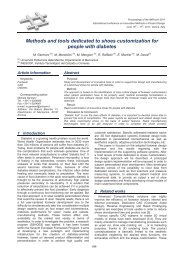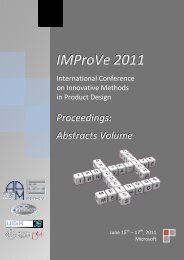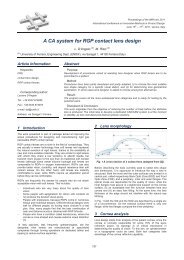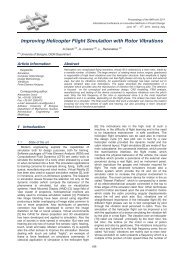IMProVe 2011 - Proceedings
IMProVe 2011 - Proceedings
IMProVe 2011 - Proceedings
You also want an ePaper? Increase the reach of your titles
YUMPU automatically turns print PDFs into web optimized ePapers that Google loves.
Reverse Engineering<br />
Construction of a geometric reference model<br />
for automatic non-ideality evaluation<br />
of an acquired high-density workpiece<br />
L. Di Angelo (a), P. Di Stefano (a), A. E. Morabito (b)<br />
(a) Department of Industrial Engineering, University of L’Aquila, Italy<br />
(b) Department of “Ingegneria dell’Innovazione”, University of Lecce, Italy<br />
Abstract:<br />
Purpose:<br />
For some years now, our research group has been developing a new methodology for<br />
automatic tolerance inspection starting from an acquired high-density 3D model. In this<br />
paper, with a view to grouping together all the information recognisable in a scanned<br />
object, a new data structure, called Recognised Geometric Model (RGM), is proposed.<br />
Based on this data structure, the evaluation of the non-idealities of the acquired object<br />
(form, orientation and location non-idealities) can be automatically carried out.<br />
Method:<br />
RGM is the result of an approach founded on the concepts of non-ideal feature and<br />
intrinsic nominal reference. The object to be inspected is segmented into a set of nonideal<br />
features and, for each of them, one or more intrinsic nominal references are<br />
identified. An Intrinsic Nominal Reference is detected when a geometric property has<br />
been recognised to be common to a set of adjacent points in the 3D data set representing<br />
the acquired object. The recognition of these references from a scanned object is carried<br />
out based on some rules which, therefore, play a leading role in the definition of the<br />
domain of the representable entities within RGM.<br />
Result:<br />
New and old categories of form non-idealities are here defined and some procedures are<br />
proposed for a more robust process of verification of traditional tolerance categories<br />
(such as the straightness of a cylinder generatrix).<br />
Discussion & Conclusion:<br />
When using the RGM, tolerances can be specified according to the set of available and<br />
recognisable intrinsic nominal references. This allows for the automatic geometric<br />
inspection of the workpiece. However, the approach here proposed does not rule out the<br />
possibility of querying the RGM data structure by explicit geometric product<br />
specifications, in order to gather some quantitative information concerning special<br />
intrinsic geometric parameters and/or non-idealities.<br />
Keywords: ISO Tolerancing, Three dimensional Metrology, Triangular Meshes, Shape<br />
recognition, Automated inspection.<br />
Corresponding Author: Luca Di Angelo<br />
e-mail: luca.diangelo@univaq.it<br />
Address: Via G. Gronchi 18, L’Aquila, Italy<br />
June 15 th – 17 th , <strong>2011</strong>, Venice, Italy<br />
75<br />
<strong>IMProVe</strong> <strong>2011</strong> - <strong>Proceedings</strong>










